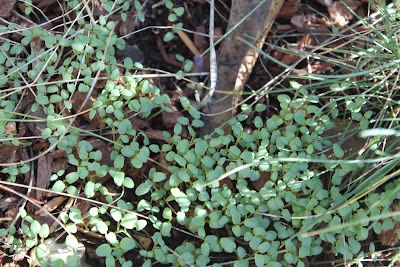Nevin Smith, in his marvelous book, "Native Treasures," addresses this annual conundrum in the aptly-named chapter "The Trouble with Annuals". He writes that while annual seeds need moisture to germinate, some "have additional mechanisms for preventing disastrous false starts. Often a certain minimum period of continuous moisture is necessary to activate them. Seeds of many species also require a certain number of cool or even frosty nights." (p. 255.) These are amazing adaptations, but I don't believe they are claimed by the particular annuals that inhabit my yard. It hasn't gotten terribly cool in my neighborhood, and the green carpets of seedlings appeared after the very first measurable rainfall.
Smith adds, "It is not uncommon for vast numbers of young seedlings to wither and die in an extended midwinter drought. Such is the nature of life in California."
Hence my dilemma. Nature can be merciless, but a garden affords the opportunity to inject a little nurture. Yet, I'm not the type of gardener who thinks gardening has much to do with control. When I first set out to plant an all-native garden, I looked at it as sort of a botanical nation-building endeavor. I did violently overthrow the ivy regime, and I installed quite a number of handpicked key players in the new native community, but the goal is for the plants to eventually have self-governance. I'll maintain a peacekeeping presence to deal with the threat of weed invasions and ivy insurgents, and I'll do some necessary housekeeping, but in terms of what thrives and what dies, what self-propagates and what fades away, I like for that to be out of my hands. I've wound the clock, now it's time to let it tick.
So all this argues for keeping the hose neatly coiled up by the faucet and letting the seedlings' fate run its course. I know I will find that hard, once I see them starting to keel. But actually, if they wither, it may be for the best; the last two years I've really had too many annuals--massive stands that choked out still-small perennials. Also, this year, the cheeky annuals are trespassing in places where they're not supposed to be, such as in my gravel-and-stone path. I guess the lesson there is to buy high-quality landscape fabric, not the cheapo permeable plastic so-called weed barrier at the home-improvement superstore. One might look at these seedlings and suspect them of being weeds, but I've seen these cotyledon rascals before, and I know them to be none other than G. capitatum, AKA globe gilia.
If this first flush of seedlings dies, perhaps later in the year a more manageably-sized crop with take its place. It could well be that nature is a better gardener than I.





I, too, am wondering about my ability to keep my California seedlings alive over the winter.
ReplyDeleteAlso, I've spent a lot of time pondering my future life in a cardboard box on the side of the road. And yet, I had failed to consider the cats' happiness in this scenario.
After much trial and tribulation with native plant gardening over the years, I finally reached the epiphany that nature should, nine times out of ten, just take its course. Btw, very cool that you're keeping track of your "backyard" birds & reptiles.
ReplyDeleteThanks for the comments. Cool name, camissonia. I figure a yard with wildlife is as good as a yard with a great view. Lisa and Robb, good luck with the seedlings! Don't worry, you'll stay out of the cardboard box--maybe to your cats' chagrin.
ReplyDelete